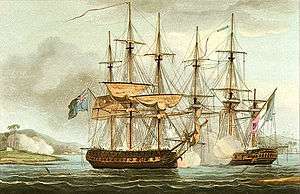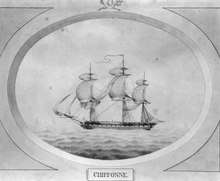French frigate Chiffone (1799)
Chiffonne was a 38-gun Heureuse-class frigate of the French Navy. She was built at Nantes and launched in 1799. The British Royal Navy captured her in 1801. In 1809 she participated in a campaign against pirates in the Persian Gulf. She was sold for breaking up in 1814.
 HMS Sybille capturing Chiffonne | |
| History | |
|---|---|
| Name: | Chiffonne |
| Laid down: | 10 November 1793 |
| Launched: | 31 August 1799 |
| In service: | December 1800 |
| Captured: | 19 August 1801 |
| Name: | Chiffonne |
| Acquired: | 19 August 1801 by capture |
| Fate: | Broken up in September 1814 |
| General characteristics [1] | |
| Class and type: | Heureuse-class frigate |
| Length: |
|
| Beam: | 37 ft 11 in (11.56 m) |
| Draught: | 5.8 m (19 ft) |
| Propulsion: | Sail |
| Complement: | French service: 250 men |
| Armament: |
|
| Armour: | Timber |
French service

On 11 July 1801, Chiffone, under the command of Captain Pierre Guiyesse arrived at Mahé, Seychelles from the port of St Nazaire with 33 deportees under sentence of exile from France. The exiles had been involved in the Plot of the Rue Saint-Nicaise against Napoleon.[2]
On 15 May, off Brazil, she captured a Portuguese schooner. Three days later she captured the Brazilian frigate Hirondelle, armed en flute. Hirondelle (or possibly Andorhina) was armed with twenty-four 24-pounder carronades and put up a short fight. Guiyesse had her guns thrown overboard, took her stores (cables, spare rigging and sails), and then released her officers and crew under parole.[2]
On 16 June, Chiffone captured the East Indiaman Bellona on her way from Bengal to London. In taking Bellone, Chiffone had her mizzen mast crippled. A prize crew under Ensign Jean-Michel Mahé took Bellona to Mauritius where she arrived a month later.[2][3]
On 19 August HMS Sibylle, Captain Charles Adam, chased her off Mahé, Seychelles. At the time of the British attack Chiffone was at anchor and aided her defense by constructing a battery using some of her forecastle guns and heating the shot.[2] Her captain, Commander Guiyesse, attempted to avoid capture by beaching Chiffonne, but the British captured her the next day. She had lost 23 men killed and 30 wounded; Sybille lost two men killed and one wounded.[2] She was brought into British service as HMS Chiffonne. When Adams arrived in Madras with his prize the insurance company there presented him with a sword worth guineas, while the merchants of Calcutta later too presented him with a sword and a piece of plate.[4]
British service
The British commissioned Chiffone in 1802 in the East Indies under Captain Henry Stuart.[1] In July 1802 she carried despatches to Calcutta with the reports of the murder of the Persian ambassador Haji Khalil Khan in Bombay. She returned to England and was fitted at Woolwich in 1803. Captain Charles Adam (late of Sibylle) took command of Chiffone on 23 May 1803 and recommissioned her for service in the North Sea and the coast of Spain, where she served from 1803 to 1807.[4]
On 5 August 1803 Chiffone, Ethalion and Cruizer captured Flore.[5] The same three vessels shared the salvage money arising from the recapture on the same day of Margaret, Robert Lacs, master.[6]
The next day Chiffonne and Ethalion captured John, of Workington.[7] Then on 20 June Chiffonne captured Zeeluft.[8] In October Chiffone was under the command of Captain Patrick Campbell, perhaps temporarily.[1]
On 10 June 1804, Chiffone and consorts engaged French gunboats. Then on 20 June Chiffonne captured another Zeeluft, or at least a vessel by that name and with a different master than that of the previous year. Chiffonne was in company with Falcon, Clinker, Steady, and the hired armed cutter Frances.[9]
On 10 June 1805, Chiffone, with Falcon, Clinker, and Frances chased a French convoy for nine hours until it took shelter under the guns of Fécamp. The convoy consisted of two corvettes (Foudre under Capitaine de vaisseau Jacques-Felix-Emmanuel Hemelin, and Audacieuse, under Lieutenant Dominique Roquebert), four large gunvessels and eight others, and 14 transports. The British suffered some casualties from gunfire from shore batteries, with Chiffone, which had borne the brunt of the firing, losing two men killed and three wounded.[10]
In May 1806 Chiffone was under the command of John Wainwright.[1] On 14 June Chiffone, which had returned to Portsmouth, sailed for Cadiz, carrying General Sir John Moore and Admiral Purvis, who had raised his flag on her. At Cadiz Purvis transferred his flag to Minotaur and Chiffone proceeded to Gibraltar. From there, on 5 July, she sailed to Messina in company with Active, Racehorse, and nineteen transports, supply vessels and merchant vessels, arriving on 7 August.[11]
At some point in early 1807, boats from Chiffone and Sabrina cut out a brig and a schooner under the guns of a 4-gun battery on the south coast of Spain.[12]
She sailed for the East Indies in May 1808. About a year and a half later, on 13 September 1809, Chiffone was in the port of Bombay when the ship Shah Ardaseer caught fire. Mr. Kempt, the chief officer, hailed the warships around her for help, and Wainright responded with 100 men, buckets, and an "engine". Despite their efforts, those of the crew, and those of men from the other British warships in the port, Ardaseer could not be saved.[13]
Then in November, she and Caroline, together with a number of East Indiamen, participated in the campaign to eradicate piracy in the Persian Gulf, centered on Ras al-Khaimah. In an attack the British began with a cannonade of the town and followed with a ground attack. They destroyed some vessels, 30 of them very large dhows, together with much in the way of naval stores. Chiffonne's casualties amounted to two men wounded.[14] She and Caroline destroyed the Persian towns of Linga and Laft on Qeshm Island. Chiffone also destroyed 20 vessels, nine of them large dhows at Linga and eleven, nine of them large dhows, at Laft. This time the resistance on shore was more intense and Chiffone lost one man killed and 17 wounded out of total British casualties (including men from the East India Company's vessels), of two killed and 27 wounded.[15]
In January 1810 Chiffonne and Caroline carried Shenaz, which had rebelled against Sultan Sa'id of Oman and which they restored to him. Syyed Sa'id presented Wainwright with a scimitar in recognition of his efforts against the pirates. In November, Chiffonne rescued the crew of Mandarin, which had wrecked on Red Island, near Singapore.[16][17]
Fate
Chiffone returned to Portsmouth in 1811. She was laid up there, but then repaired in 1812. In 1813 to 1814 she was in ordinary.[1]
The Principal Officers and Commissioners of His Majesty's Navy offered "Chiffonne, of 36 guns and 945 tons", lying at Portsmouth, for sale on 11 August 1814. The buyer had to post a bond of £3,000, with two guarantors, that they would break up the vessel within a year of purchase.[18] She was sold for breaking up for £1,700 at Portsmouth on 1 September 1814.[1]
Citations
- Winfield (2008), p. 210.
- "No. 15454". The London Gazette. 16 February 1802. pp. 165–166.
- Quintin & Quintin (2003), p. 254.
- Conolly (1868), pp. 2–3.
- "No. 15681". The London Gazette. 6 March 1804. p. 288.
- "No. 15702". The London Gazette. 15 May 1804. p. 628.
- "No. 15720". The London Gazette. 17 July 1804. p. 878.
- "No. 15773". The London Gazette. 19 January 1805. p. 96.
- "No. 15874". The London Gazette. 21 December 1805. p. 1600.
- James (1837), Vol. 3, pp.307-8.
- Moore (1804), pp. 120–2.
- O'Byrne (1849), p. 197.
- Naval Chronicle, Vol. 23, (January–July 1810), pp.279-80.
- "No. 16386". The London Gazette. 10 July 1810. pp. 1022–1023.
- "No. 16386". The London Gazette. 10 July 1810. pp. 1023–1024.
- O'Byrne (1849), p. 579.
- Hepper (1994), p. 134.
- "No. 16920". The London Gazette. 26 July 1814. p. 1510.
References
- Conolly, Mathew Forster (1868). Biographical dictionary of eminent men of Fife of past and present times: natives of the county, or connected with it by property, residence, office, marriage, or otherwise. Inglis & Jack.
- Hepper, David J. (1994). British Warship Losses in the Age of Sail, 1650–1859. Rotherfield: Jean Boudriot. ISBN 0-948864-30-3.
- O'Byrne, William R. (1849). A Naval Biographical Dictionary: comprising the life and services of every living officer in Her Majesty's navy, from the rank of admiral of the fleet to that of lieutenant, inclusive. London: J. Murray.
- James, William (1837). The Naval History of Great Britain, from the Declaration of War by France in 1793, to the Accession of George IV. R. Bentley.
- Moore, Sir John (1804). The diary of Sir John Moore. 2. E. Arnold.
- Quintin, Danielle; Quintin, Bernard (2003). Dictionnaire des capitaines de Vaisseau de Napoléon (in French). S.P.M. ISBN 2-901952-42-9.
- Winfield, Rif (2008). British Warships in the Age of Sail 1793–1817: Design, Construction, Careers and Fates. Seaforth Publishing. ISBN 1-86176-246-1.
External links

- Naval Database